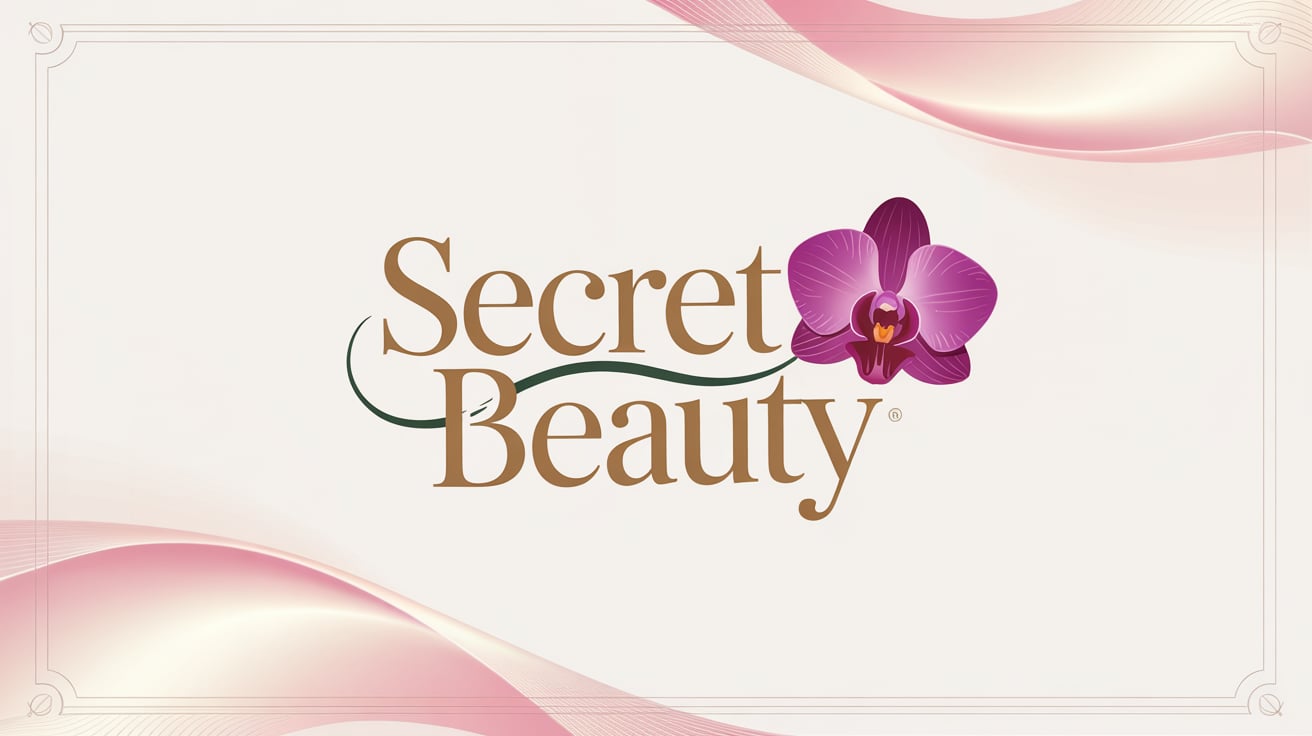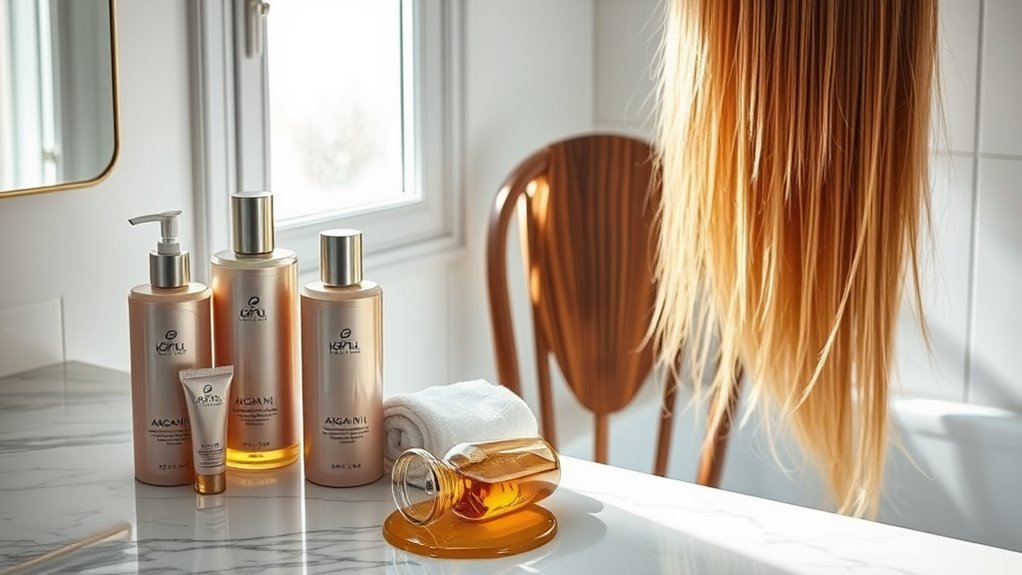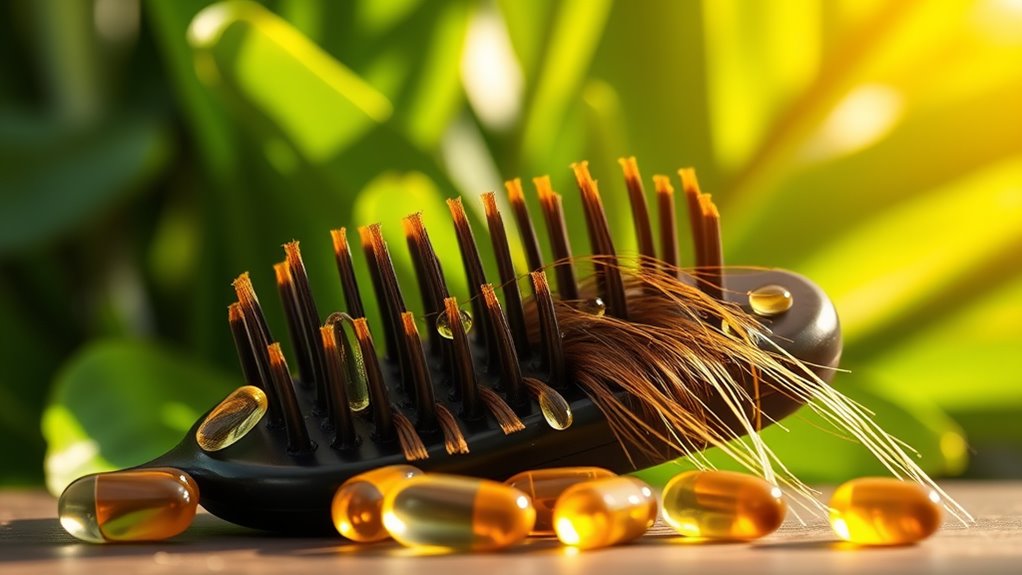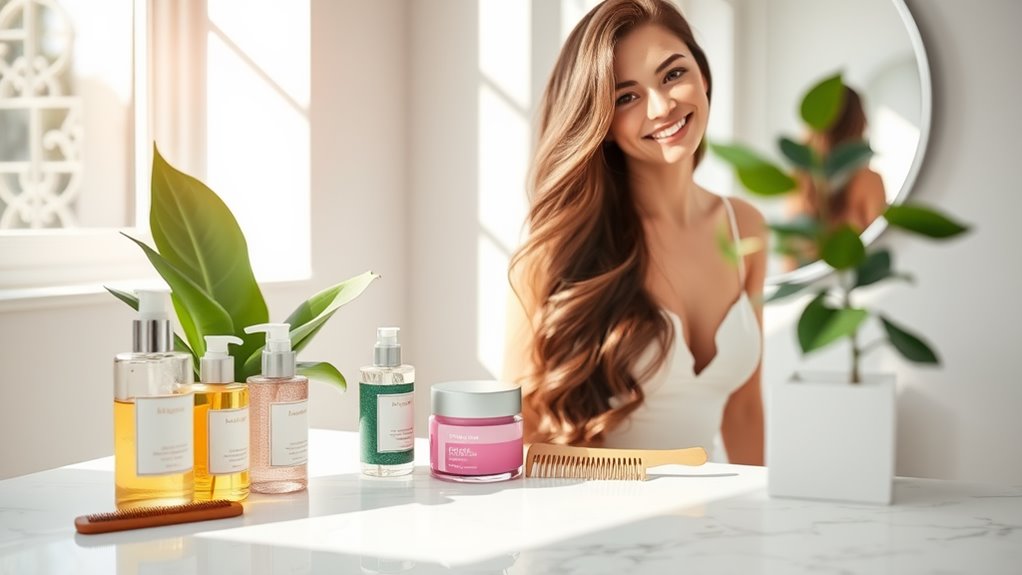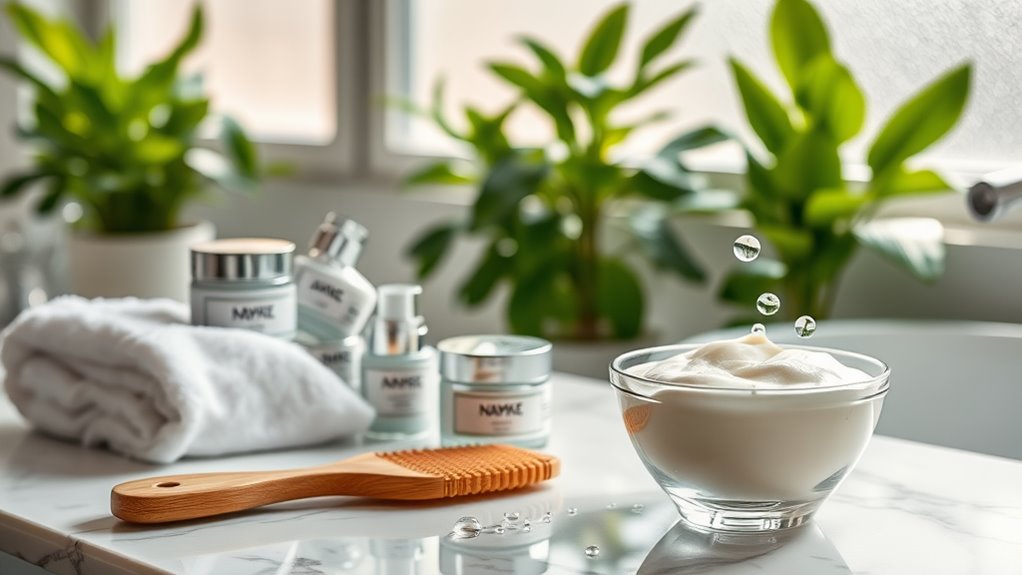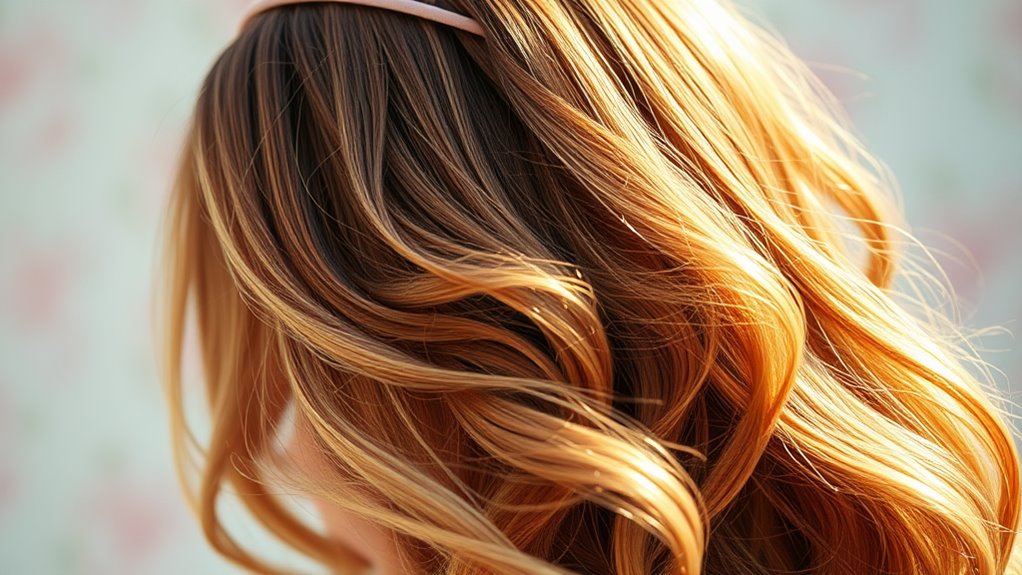Hair Routine That Made My Hair Stronger and Softer
To make your hair stronger and softer, start by evaluating your hair type and needs. Choose a sulfate-free shampoo and a nourishing conditioner tailored to your hair. Incorporate deep conditioning treatments weekly and use oils like argan or coconut from mid-length to ends for added moisture. Protect your hair from heat damage with a quality heat protectant and maintain a healthy diet rich in vitamins and nutrients. There’s a lot more you can do to enhance your hair care routine.
Key Takeaways
- Assess your hair type and porosity to tailor a routine that meets your specific needs for strength and softness.
- Use sulfate-free shampoos and nourishing conditioners with essential oils and proteins to hydrate and strengthen hair.
- Incorporate weekly deep conditioning treatments to address damage and enhance moisture retention for softer hair.
- Apply heat protectants before styling to shield hair from damage and maintain its overall integrity and softness.
- Maintain a balanced diet rich in proteins, omega-3 fatty acids, and vitamins to promote healthy hair growth and resilience.
Assessing Your Hair Type and Needs
How well do you really know your hair? Understanding your hair type is vital for achieving stronger hair.
Start by examining its texture—fine, medium, or coarse. Each type has unique needs.
Next, assess your hair’s porosity. Is it easily saturated or resistant to moisture? This will dictate how well products absorb.
Don’t forget to take into account your scalp’s health; an oily or dry scalp affects overall hair strength too.
Check for damage—split ends or brittleness indicate your hair needs special attention.
Incorporating personalized hair care routines based on these assessments can lead to optimal results.
By mastering your hair’s characteristics, you can tailor your routine effectively, promoting stronger hair.
Choosing the Right Shampoo and Conditioner
When selecting a shampoo and conditioner, it’s crucial to check the ingredients to guarantee they’re right for your hair.
Look for sulfate-free options that cleanse without stripping your hair of its natural oils. Additionally, consider incorporating products that contain essential nutrients known to support hair growth and strength, such as biotin and collagen.
Ingredients to Look For
Choosing the right shampoo and conditioner is essential for achieving stronger and softer hair, especially since the ingredients in these products can make all the difference.
Look for shampoos containing nourishing oils like argan or jojoba, which hydrate and repair. Proteins, such as keratin, can also strengthen your hair, providing structure and resilience.
Additionally, seek out humectants like glycerin that attract moisture, ensuring your hair remains soft and manageable. Natural extracts, like aloe vera and chamomile, can soothe your scalp and promote overall health.
When selecting your conditioner, prioritize those with emollients that seal in moisture and reduce frizz.
Sulfate-Free Options
Many people are discovering the benefits of sulfate-free shampoos and conditioners, which can be gentler on your hair and scalp.
These products cleanse without stripping away natural oils, promoting balance and hydration. When choosing sulfate-free options, look for those enriched with nourishing ingredients like aloe vera, argan oil, or shea butter.
These elements not only enhance moisture but also improve hair texture and manageability. It’s essential to read labels carefully; some products may still contain harsh additives.
Experiment with different brands to find what best suits your hair type and concerns. Incorporating sulfate-free products into your routine can lead to stronger, softer hair, transforming your locks into a healthy crowning glory.
Embrace this change, and watch your hair thrive.
Incorporating Deep Conditioning Treatments
To achieve stronger and softer hair, incorporating deep conditioning treatments into your routine is essential. Aim for a deep conditioner rich in proteins and essential oils, as these ingredients penetrate the hair shaft, repairing damage and enhancing moisture retention.
Use it once a week or bi-weekly, depending on your hair’s needs. Apply the treatment generously, focusing on the mid-lengths and ends, where damage often occurs.
For maximum effectiveness, consider using heat; a warm towel or a shower cap traps heat, allowing the product to work deeper. After the recommended time, rinse thoroughly with cool water to seal in the benefits. Additionally, remember that a weekly hair mask routine can significantly improve overall hair health and shine.
Consistency is key—over time, you’ll notice a remarkable difference in the strength and softness of your hair.
Utilizing Hair Oils and Serums
To boost the strength and softness of your hair, incorporating hair oils and serums can make a big difference.
You’ll want to choose the best oils for your hair type and master the right application techniques.
Plus, selecting the right serum can elevate your routine to a whole new level. Additionally, using a blend of essential oils and carrier oils can enhance scalp health and promote hair growth.
Best Hair Oils
When it comes to achieving stronger and softer hair, the right hair oils and serums can make all the difference.
Look for oils packed with nourishing ingredients like argan, jojoba, and coconut. Argan oil is renowned for its ability to hydrate and repair, while jojoba mimics your scalp’s natural oils, promoting balance. Coconut oil penetrates the hair shaft, providing deep moisture and preventing breakage.
Don’t overlook essential oils like rosemary and lavender, which stimulate growth and soothe the scalp.
For serums, choose those that contain silicones for a protective barrier against damage and frizz.
Incorporating these powerful oils and serums into your routine not only enhances hair strength but also imparts a luxurious softness that you’ll love.
Application Techniques
While applying hair oils and serums might seem simple, mastering the technique can elevate your hair care routine considerably.
Start by warming a few drops of oil or serum between your palms. This activates the ingredients and guarantees even distribution.
Section your hair into manageable parts, applying the product from mid-length to the ends, where dryness usually occurs. Avoid your scalp to prevent greasiness.
Use a gentle, downward motion to avoid breakage and promote shine. For deeper penetration, consider a light scalp massage to stimulate circulation.
Finally, don’t forget to adjust the amount based on your hair type; finer hair requires less product, while thicker hair may need more.
Consistency is key, so make it part of your routine!
Choosing the Right Serum
How do you choose the right serum for your hair type and concerns? Start by identifying your hair’s specific needs. Serums can address issues like frizz, dryness, or damage. The right choice can greatly enhance your hair’s health.
Here’s a quick reference table to guide you:
| Hair Concern | Recommended Serum Type | Key Ingredients |
|---|---|---|
| Frizz | Anti-frizz serum | Argan oil, silicone |
| Dryness | Hydrating serum | Jojoba oil, vitamin E |
| Damage | Repair serum | Keratin, amino acids |
| Thin Hair | Volumizing serum | Panthenol, biotin |
| Color-Faded | Color-protecting serum | UV filters, antioxidants |
Implementing a Regular Scalp Care Routine
To achieve stronger and softer hair, prioritizing your scalp care routine is essential. Start by cleansing your scalp regularly with a gentle shampoo to remove buildup and excess oil.
Follow up with a nourishing scalp treatment that stimulates blood flow and promotes hair growth. Incorporate exfoliation into your routine once a week; this helps eliminate dead skin cells and unclogs hair follicles.
Don’t forget to massage your scalp during washes; this not only enhances circulation but also relaxes you. Finally, consider using natural oils, like tea tree or peppermint, for added benefits. Additionally, maintaining a balanced scalp pH is crucial for a healthy scalp environment that fosters optimal hair growth.
Protecting Your Hair From Heat Damage
After establishing a solid scalp care routine, it’s time to focus on protecting your hair from heat damage.
Heat styling tools can weaken your hair, but with some strategic steps, you can minimize the risk. Here are four essential practices you should adopt:
-
Use a Heat Protectant****: Always apply a high-quality heat protectant before using any styling tools to shield your strands.
-
Lower the Temperature: Adjust the heat settings on your tools to the lowest effective temperature for your hair type.
-
Limit Heat Exposure: Reduce the frequency of heat styling sessions. Opt for air-drying or protective styles when possible.
-
Invest in Quality Tools: Choose professional-grade styling tools that distribute heat evenly and minimize damage.
Maintaining a Healthy Diet for Hair Health
While you may focus on external treatments for your hair, the foundation of strong and vibrant locks actually starts from within. A balanced diet rich in essential nutrients is essential for hair health.
Incorporate proteins, like lean meats and legumes, to support hair structure. Omega-3 fatty acids found in fish and flaxseed promote scalp health and shine.
Don’t forget vitamins A, C, and E—they boost circulation and protect against oxidative stress. Iron and zinc from leafy greens and nuts enhance growth and strength.
Staying hydrated also plays an important role; water helps transport nutrients to your scalp.
Frequently Asked Questions
How Often Should I Change My Hair Products?
You should evaluate your hair products every few months. If your hair feels dull or unresponsive, it’s time to switch things up. Experimenting with new products can enhance your routine and keep your hair thriving.
Can Stress Affect My Hair’s Health?
Absolutely, stress can greatly impact your hair’s health. It may lead to hair thinning or loss, as elevated cortisol levels disrupt the hair growth cycle. Managing stress through relaxation techniques can help maintain your hair’s liveliness.
What Are the Signs of Damaged Hair?
When you notice split ends, excessive dryness, or brittleness, your hair’s likely damaged. It may also feel rough to the touch or lack shine. Pay attention to these signs, as they indicate your hair needs care.
Is It Okay to Skip Conditioner Sometimes?
It’s okay to skip conditioner occasionally, especially if your hair feels weighed down. Just remember, doing so too often might lead to dryness. Listen to your hair’s needs and adjust your routine accordingly for ideal health.
How Can I Prevent Split Ends Effectively?
To effectively prevent split ends, you should regularly trim your hair, use nourishing oils, and avoid excessive heat styling. Additionally, maintaining a balanced diet rich in vitamins can strengthen your hair from within.
